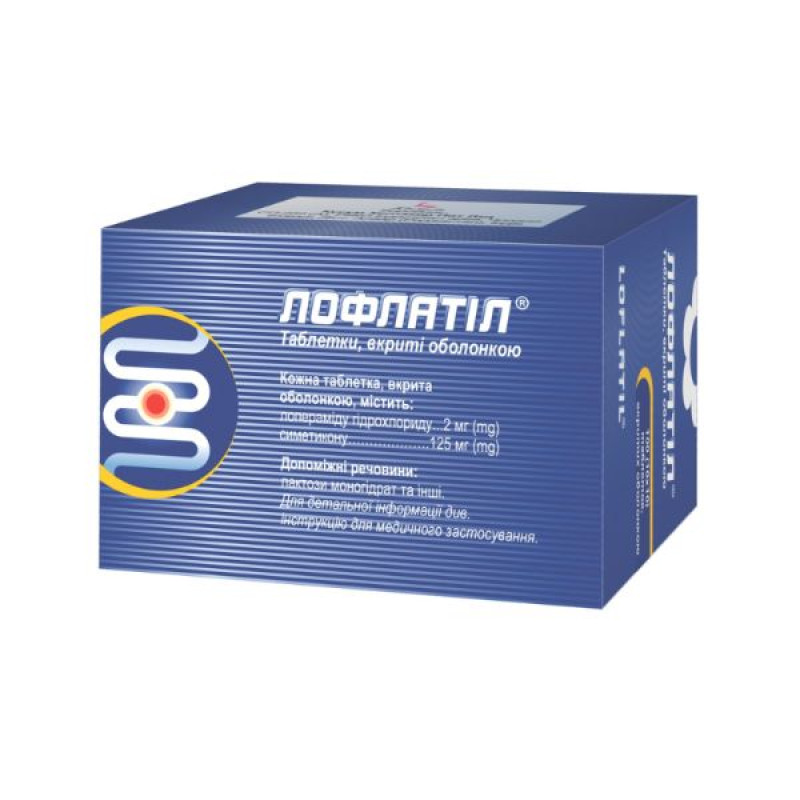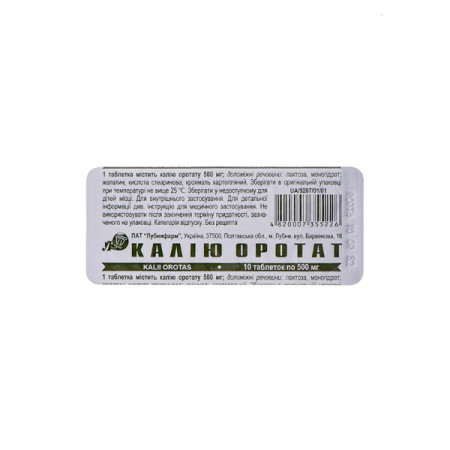Loflatil film-coated tablets blister pack No. 100

Pharmacological properties
Pharmacodynamics. Loflatil is a combination drug that combines two drugs: loperamide hydrochloride and simethicone.
Mechanism of action of loperamide hydrochloride. Loperamide hydrochloride binds to opiate receptors in the intestinal wall. As a result, the release of acetylcholine and prostaglandins is inhibited, thereby reducing propulsive peristalsis and increasing the transit time of the contents through the digestive tract, as well as the ability of the intestinal wall to absorb fluid. Loperamide hydrochloride increases the tone of the anal sphincter, thereby reducing fecal incontinence and the urge to defecate.
Mechanism of action of simethicone. Simethicone is a non-toxic, inert surface-active compound that has antifoaming properties and therefore relieves symptoms associated with diarrhea, including flatulence, abdominal discomfort, bloating, and cramps.
Pharmacokinetics
For loperamide hydrochloride
Absorption: Most of the orally administered loperamide is absorbed in the intestine, but as a result of extensive first-pass metabolism, systemic bioavailability is only 0.3%.
Distribution: Distribution studies of loperamide in rats show a high affinity for the intestinal wall with preferential binding to receptors in the longitudinal muscle layer. Loperamide is 95% protein bound, mainly to albumin. Preclinical data have shown that loperamide is a substrate for P-glycoprotein.
Metabolism: Loperamide is almost completely excreted by the liver, where it is mainly metabolized, conjugated and excreted in the bile. Oxidative N-demethylation is the main metabolic pathway of loperamide, this process is mediated mainly by CYP 3A4 and CYP 2C8 isoforms. As a result of the very intense first-pass effect through the liver, plasma concentrations of unchanged drug remain very low.
Elimination: T½ of loperamide in humans is ≈11 hours with a range of 9-14 hours. Unchanged loperamide and its metabolites are excreted mainly in the feces.
Paediatric population: Pharmacokinetic studies in paediatric patients have not been conducted. The pharmacokinetic behaviour of loperamide and drug interactions with loperamide are expected to be similar to those observed in adults.
for simethicone
Simethicone acts exclusively on the surface of gas bubbles and is not absorbed by the mucous membrane of the digestive tract. Simethicone is not absorbed by the mucous membrane of the digestive tract and is excreted unchanged after oral administration. Simethicone has no central action.
Indication
Symptomatic treatment of acute diarrhea in adults and children aged 12 years and over, accompanied by abdominal discomfort, including bloating, spastic pain and flatulence.
Application
Adults. The initial dose is 2 tablets at a time, then 1 tablet after each act of defecation, but not more than 4 tablets per day. Duration of use - no more than 2 days.
Children over 12 years of age. Initial dose - 1 tablet once, then - 1 tablet after each act of defecation, but not more than 4 tablets per day. Duration of use - no more than 2 days.
Elderly patients: No dose adjustment is required in the treatment of elderly patients.
Renal impairment: No dose adjustment is required for patients with renal impairment.
Hepatic impairment. Although pharmacokinetic data on the effect of the drug in patients with impaired hepatic function are lacking, Loflatil should be administered to them with caution due to a slowdown in first-pass metabolism (see Precautions).
Contraindication
Loflatil is contraindicated in patients with:
Hypersensitivity to loperamide, simethicone or any component of the drug; acute dysentery, characterized by the presence of blood in the stool and elevated body temperature; acute ulcerative colitis; pseudomembranous colitis associated with the use of broad-spectrum antibiotics; bacterial enterocolitis caused by microorganisms of the Salmonella, Shigella and Campylobacter families; intestinal obstruction or obstructive diseases of the digestive tract.Loflatil should not be used at all if it is necessary to avoid inhibition of peristalsis due to the possible risk of significant complications, including intestinal obstruction, megacolon, and toxic megacolon.
The drug should be discontinued immediately if constipation, bloating, or intestinal obstruction develop.
Side effects
Immune system disorders: hypersensitivity reactions, anaphylactic reactions, including anaphylactic shock, anaphylactoid reactions.
Skin and subcutaneous tissue disorders: skin rash, urticaria, pruritus, angioedema, bullous rash (including Stevens-Johnson syndrome), erythema multiforme, toxic epidermal necrolysis.
Gastrointestinal tract: dry mouth, nausea, constipation, megacolon (including toxic megacolon), intestinal obstruction (including paralytic ileus), abdominal pain, abdominal discomfort, vomiting, abdominal distension, dyspepsia, flatulence.
From the nervous system: headache, dysgeusia (change in taste), drowsiness, dizziness, depression of consciousness, loss of consciousness, stupor, hypertonicity, impaired coordination.
From the urinary system: urinary retention.
General disorders: asthenia, fatigue.
Special instructions
Treatment of diarrhea with loperamide and simethicone is symptomatic. If the etiology of the disease can be determined (or it is indicated that it should be done), specific treatment should be carried out if possible.
Dehydration and electrolyte imbalances may occur in patients with diarrhea, especially in children and the elderly. In such cases, the most important measure is the use of replacement therapy to replenish fluids and electrolytes.
The use of the drug does not replace the administration of an appropriate amount of fluid and restoration of electrolytes.
Since persistent diarrhea may indicate a potentially serious condition, the drug should not be used for a long time until the cause of the diarrhea is proven.
In case of acute diarrhea, when no clinical improvement is observed within 48 hours, the use of Loflatil should be discontinued and a doctor should be consulted.
Patients with AIDS who are taking Loflatil for diarrhea should immediately discontinue treatment at the first signs of abdominal distension. There are isolated reports of intestinal obstruction with an increased risk of toxic megacolon in patients with AIDS, with infectious colitis of both viral and bacterial etiology during treatment with loperamide.
Although pharmacokinetic data are not available for patients with hepatic impairment, Loflatil should be used with caution in such patients due to decreased first-pass metabolism. This drug should be administered with caution to patients with hepatic impairment as it may result in relative overdose, which may result in CNS toxicity.
Drugs that prolong transit time may lead to the development of toxic megacolon in this group of patients.
Although loperamide is well metabolized and loperamide or its metabolites are excreted in the feces, it is usually not necessary to adjust the dose of Loflatil in patients with impaired renal function.
Since the drug contains lactose, it should not be used in patients with rare hereditary forms of galactose intolerance, the Lapp lactase deficiency or glucose-galactose malabsorption syndrome.
If the drug is taken to control diarrhea attacks due to previously diagnosed irritable bowel syndrome (IBS), and clinical improvement is not observed within 48 hours, loperamide should be discontinued and a doctor should be consulted. A doctor should also be consulted if the nature of the symptoms changes or if recurrent diarrhea attacks last more than 2 weeks.
For the treatment of acute attacks of diarrhea caused by IBS, Loflatil should only be taken when a doctor has previously diagnosed this disease.
The following conditions should not be used without prior consultation with a doctor, even if the patient knows that he has IBS:
the patient is 40 years old and it has been some time since the last IBS attack; the patient is 40 years old and the IBS symptoms are different this time; recent intestinal bleeding; severe constipation; nausea or vomiting; loss of appetite or weight loss; difficult or painful urination; fever; recent travel abroad.If new symptoms occur, symptoms worsen, or if symptoms do not improve within 2 weeks, you should consult a doctor.
Use during pregnancy and breastfeeding. It is not recommended to take this drug during pregnancy and breastfeeding. In this regard, pregnant and breastfeeding women should consult a doctor for appropriate treatment.
Ability to influence the reaction rate when driving vehicles or working with other mechanisms. During treatment, you should refrain from driving vehicles and working with other mechanisms.
Children: Do not use in children under 12 years of age.
Interactions
Interactions related to loperamide
Cases of interaction with drugs with similar pharmacological properties have been reported. Drugs that have an inhibitory effect on the central nervous system are not recommended for use simultaneously with Loflatil in children.
Preclinical data indicate that loperamide is a substrate of P-glycoprotein. Concomitant administration of loperamide (16 mg) with P-glycoprotein inhibitors (quinidine, ritonavir) resulted in a 2- to 3-fold increase in plasma loperamide levels. The clinical significance of this pharmacokinetic interaction at recommended doses of loperamide is unknown.
Concomitant administration of loperamide (16 mg once daily) and ketoconazole, an inhibitor of CYP 3A4 and P-glycoprotein, resulted in a five-fold increase in plasma concentrations of loperamide. This increase was not associated with an increase in the severity of pharmacodynamic effects, as determined by pupillometry.
Concomitant treatment with oral desmopressin resulted in a three-fold increase in plasma desmopressin concentrations, probably due to decreased gastrointestinal motility.
It is expected that drugs with similar pharmacological properties may enhance the effect of loperamide, and drugs that accelerate the passage of food through the gastrointestinal tract may reduce its effect.
Interactions related to simethicone
Levothyroxine may bind to simethicone. The absorption of levothyroxine in the intestine may be impaired when taken simultaneously with simethicone.
Overdose
Symptoms: in case of overdose (including overdose due to impaired liver function), central nervous system depression (stupor, impaired coordination of movements, drowsiness, miosis, increased muscle tone, respiratory depression) and paralytic intestinal obstruction, urinary retention are possible. In childhood, central nervous system depression may occur more often.
Treatment. In case of overdose, the patient should immediately consult a doctor. If symptoms of overdose occur, the patient should be administered naloxone as an antidote. Since T ½ of loperamide is greater than T ½ of naloxone (1-3 hours), additional administration of naloxone may be required. 24-hour monitoring of respiratory function is necessary. The patient's condition should be carefully observed for at least 48 hours to detect possible CNS depression.
Storage conditions
At a temperature not exceeding 25 °C.
There are no reviews for this product.
There are no reviews for this product, be the first to leave your review.
No questions about this product, be the first and ask your question.







